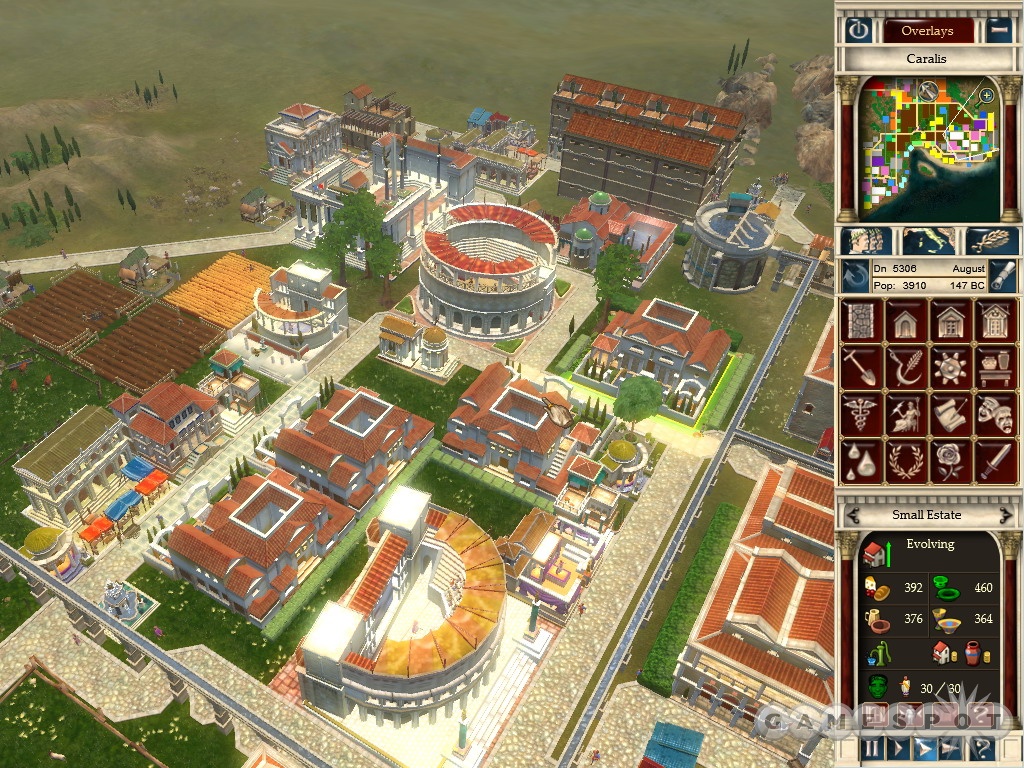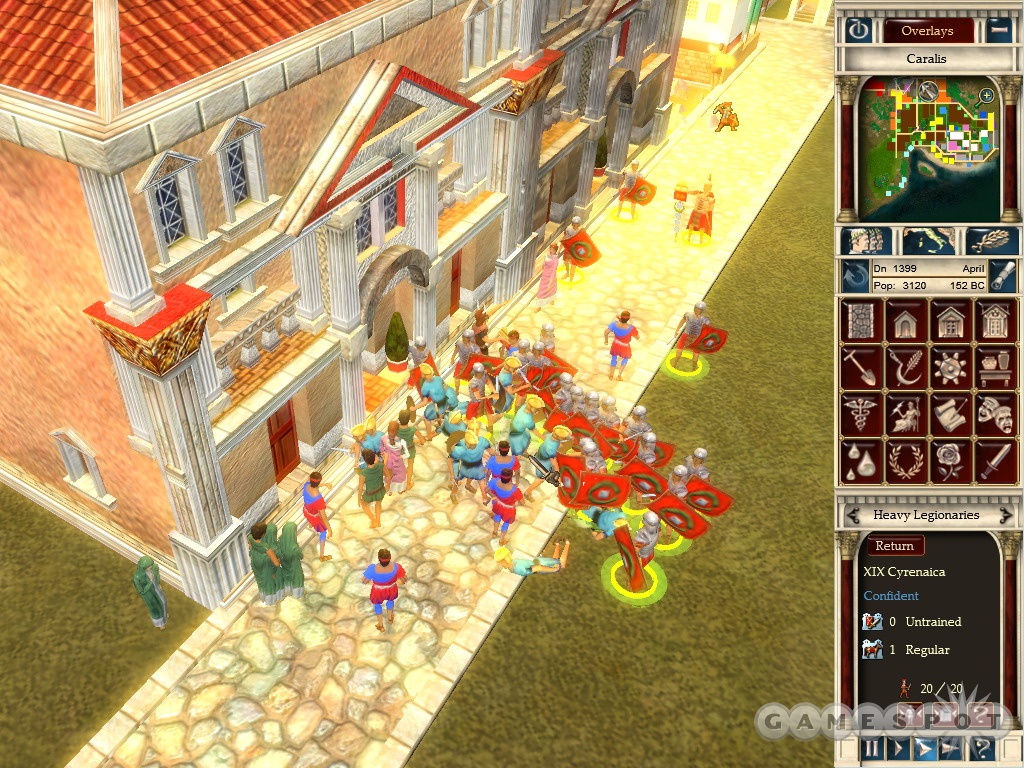Rome may not have been built in a day, but that's certainly part of the appeal of the Caesar series, the long-running city-building strategy franchise that lets you build cities for the glory of Rome. Though set thousands of years in the past, it turns out that the people of Rome had wants and needs similar to our own, and coming up with solutions can be both entertaining and educating, in a way. As the first new entry in eight years, Caesar IV updates the series to the 3D graphics age. Caesar IV was developed by Tilted Mill, which itself is composed of veterans of previous Caesar games, so the designers knew what they were doing. As a result, this new Caesar captures the spirit of the earlier games quite well, though not without some quirks and issues.

Your main goal in Caesar IV is to build thriving Roman cities while accomplishing a series of objectives. For example, Rome may need a thriving port to supply goods to the Empire, or you may need to create a cultural center to impress Rome's neighbors. Whatever the case, this usually means that you'll start with an empty map and, from there, construct a working city. Trying to squeeze a functional metropolis into the landscape isn't easy, though it can be rewarding.
Like most city-building games, Caesar IV is about setting up the interconnected chains that civilization relies upon. You have to handle every detail, including housing, sanitation and health care, food production and distribution, security, religion, and more. Having plenty of workers means nothing if you can't keep them fed, nor does having lots of buildings if you don't have enough engineers to maintain them. The sheer variety of structures that you can build is impressive, and one of the satisfying moments in the game is when you do construct a self-sufficient city that produces such a large variety of goods. There's something almost hypnotic about watching your workers and citizens roam your city, go to work, buy goods, watch gladiator games, and more. It's not enough to simply build structures, either, as you have to keep an eye on aesthetics. People, even poor people, don't want to live near an ugly eyesore, which means building in buffer room between your industrial areas and your residential areas or placing lots of decorative items such as plants and statues to help improve the desirability of an area.
Caesar IV captures the class system of the Roman Empire ably. At the bottom are the plebs, who toil in the fields and factories and have only basic needs, such as food and clothing. Next up are the equites, or the middle class, who live in fancier structures and serve as the teachers, tax collectors, and doctors of the Empire. As such, they get paid more and have basic and luxury wants, such as furniture and wine. Finally, there are the nobles that live on huge estates. The nobles don't work for a living, and they require basic, luxury, and exotic goods to stay happy, but at least you can tax them to generate a fair chunk of your revenue. Any functional city needs to have a mix of all three classes, which makes striking the balance challenging. You need nobles because they're the only ones who can really be taxed, but to get nobles, you need to build a vast infrastructure to support them. For instance, you must trade to get exotic goods that the nobles require, and that means creating an export economy to generate something you can trade.

The trade aspect is one of the ways in Caesar IV that your city can tie into the Roman world as a whole. Instead of merely being an isolated satellite, you can open up trade ties with other cities. Ships will come in to pick up and deliver goods, which can thus fuel your economic growth. On a more pressing note, Rome will often make demands of you to deliver food, goods, or money. Fail to keep up with Rome's demands, and your imperial rating will plummet, making it harder to win certain scenarios, as well as putting you in danger of being replaced by Rome for your incompetence. In that case, you can try placating the Senate with gifts. Of course, the easier method is simply to keep up with Rome's demands, and that means building a strong economy.
Still, the economy can be finicky to manage, as bottlenecks can erupt in several places. Having no spare warehouse space often means that products sit in the factories, waiting to be distributed, and it's almost impossible to unload unwanted goods to make room, short of razing the warehouse and building a new one. This can be avoided with a lot of micromanagement of the economy, as you can tell warehouses to only stock so much of certain goods, but there ought to be a simpler way of dealing with this, as well, like dumping products into someone else's hands.
Then there's the entire concept of building legions and defenses and defending the city from the occasional barbarian horde. Simply put, constructing walls around your city is a pain thanks to the strict building restrictions that often have you tear down and rebuild parts of your city to squeeze in walls. With that said, it's a bit easier to simply build a fort and recruit a legion to kill the pesky barbarians whenever they appear.
Caesar IV also manages to incorporate an online element into a traditionally single-player genre. You won't be building cities alongside other players in a cooperative game, but Caesar IV does let you challenge players in a couple of ways. Caesar's Challenge is for the veteran players who want to determine who the best is. These are basically a series of challenges that require you to create a city to generate the most money, highest scoring city, and so on. Your performance on each scenario is ranked, with the top performer getting all the glory. If you're looking for a less competitive challenge, the persistent online Empire allows you to build and upload cities. The more cities that you build, the greater your overall Empire. You can then compare your cities to those of other players on the official Caesar IV site.

Visually, Caesar IV has a solid look to it, though the graphics border a bit more on workmanlike than on sheer beauty. Still, from a distance, it's easy to appreciate the sense of having a virtual city come to life on your screen. There are some good-looking lighting and weather effects, as well as reflective water, though dynamic shadows can cripple the overall performance. Disabling shadows means the graphics lose a bit of their luster, but the game doesn't chug whenever you shift the camera angle. However, two bigger issues are the lengthy long load times and the stability problems, as the game froze up on us quite a bit, making the aforementioned load times even more tedious. There's a musical score that blends in nicely in the background during the many hours of gameplay, and you do get verbal feedback to how you're doing whenever you click on a citizen.
Despite some of the aforementioned flaws, Caesar IV can be an engrossing game at times. Each scenario can easily take hours to accomplish, but somehow time flies by as you constantly struggle to solve the next urban design challenge you're presented with. Between the game's campaigns, scenarios, and (albeit unwieldy) scenario editor, there's a lot of content for any would-be Roman governor to enjoy.